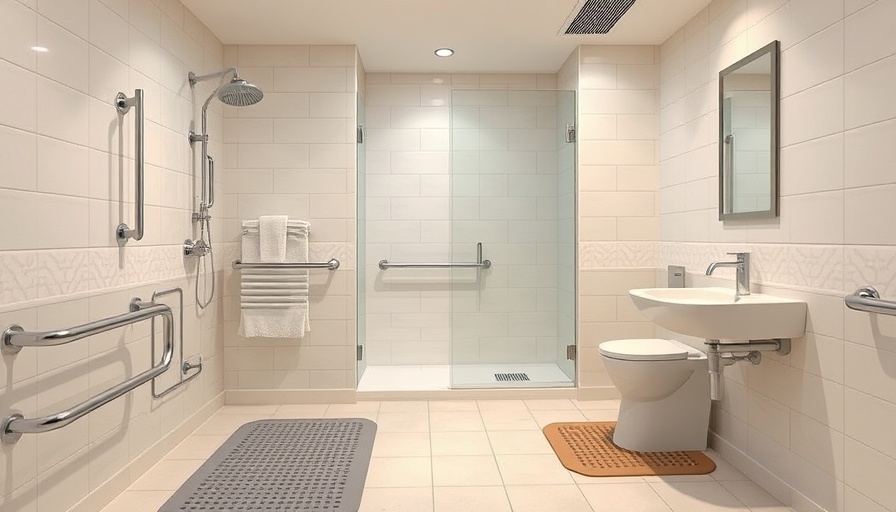
Understanding the Critical Importance of Bathroom Safety for Seniors
As our loved ones age, ensuring their safety becomes a paramount concern, particularly in high-risk areas of the home such as the bathroom. With wet floors and slippery surfaces, the bathroom can be fraught with danger for seniors, where a misplaced step could lead to severe injuries. According to the Centers for Disease Control and Prevention (CDC), falls are the leading cause of injury among older adults, with bathrooms being one of the most common places for such incidents. This highlights the fundamental necessity of maintaining a safe bathroom environment, not just for the physical well-being, but also for emotional health. Seniors who can navigate their bathrooms securely are more likely to maintain their independence, dignity, and overall quality of life.
Key Features Every Bathroom Needs for Senior Safety
To create a protective space for seniors, key bathroom features must be prioritized. Grab bars and handrails should be installed strategically near the toilet and in the shower. These features provide essential support that aids in transitioning between standing and sitting. It is crucial that these bars are securely mounted and capable of supporting the user’s weight. Another significant feature is the use of non-slip mats. These should be made from water-resistant materials and placed in areas prone to getting wet, such as the shower and beside the bathtub. Lastly, proper lighting cannot be underestimated; use full-spectrum bulbs that mimic natural light to help seniors see clearly and reduce the risk of accidents, while night lights should illuminate paths to the bathroom.
Accessibility Plays a Major Role in Bathroom Safety
Accessibility isn't just a feature—it's a life-enabler for seniors. For many, traditional bathtubs present an insurmountable barrier. Walk-in tubs and barrier-free showers are crucial installations that allow seniors to bathe safely without the challenge of climbing over high edges. These installations often come equipped with built-in seating and grab bars, fostering both safety and comfort. Additionally, the height of toilets can also pose challenges for seniors. Elevated toilets or specially designed toilet seats can alleviate strain and difficulty, making it easier for seniors to use the restroom independently.
Emphasizing the Social Connection and Value of a Safe Bathroom
Investing in bathroom safety is not merely an issue of physical health; it has emotional and social implications as well. Seniors who feel secure in their bathrooms experience higher levels of autonomy and self-respect. Families and caregivers should be aware of the powerful impact a safe bathroom has on their loved ones’ confidence and mental well-being. The conversations and consultations around bathroom safety should prioritize the feelings of the elderly, ensuring their say in modifications to their own living spaces. Engaging seniors in discussions about safety enhancements helps in creating a holistic safety strategy that respects their autonomy while safeguarding their wellness.
Implementing Practical Insights and Best Practices for Safety
Creating a safe bathroom isn’t just about installing features; it requires a strategic approach to home modifications. Begin with a thorough assessment of the current bathroom layout. Identify potential hazards such as slippery floors, inadequate support structures, and poor lighting. Engage in a conversation with the senior about their daily routine, understanding their unique challenges, and tailoring solutions accordingly can provide immediate benefits. Additionally, consider utilizing resources from local home improvement stores or hiring professionals who specialize in aging-in-place to ensure installations meet safety standards.
A Future Focused on Smooth Independence
As the population ages, the importance of accessible and safe living spaces will continue to escalate. With increasing awareness of the needs of seniors, manufacturers and designers are innovating in bathroom safety and accessibility features. Predicted trends indicate a rise in smart home technology for the elderly, such as automated lighting or temperature controls that could further aid in creating a serene and safe bathroom environment. Embracing these innovations today not only provides immediate benefits but also ensures our loved ones receive the safest, most comfortable experience possible.
In conclusion, ensuring bathroom safety for seniors is a crucial pursuit that extends beyond mere accident prevention. By fostering a safe environment, we empower our elderly relatives to live with dignity and autonomy. Consider implementing some of these practical enhancements today to create a space that prioritizes both comfort and safety. Don't leave it up to chance; take proactive steps toward making your bathroom a haven.
 Add Row
Add Row  Add
Add 




 Add Row
Add Row  Add
Add 

Write A Comment